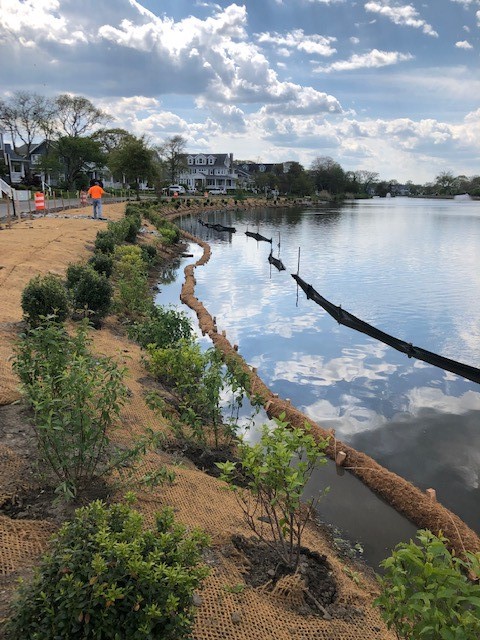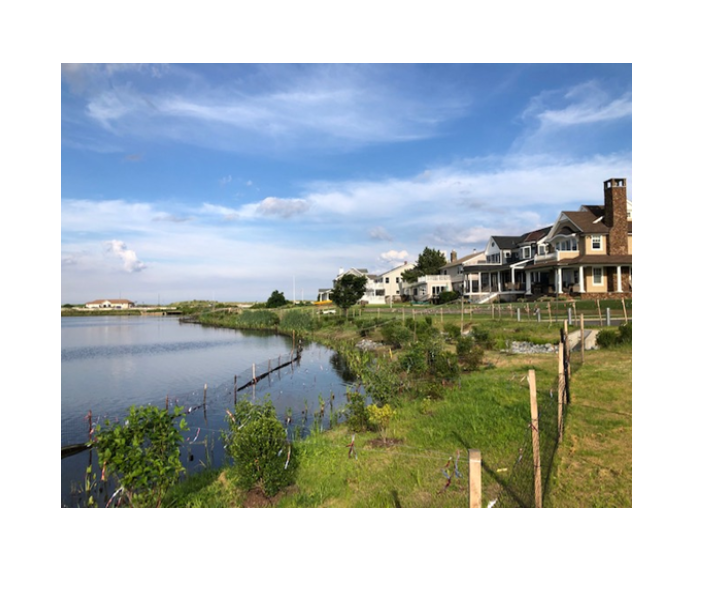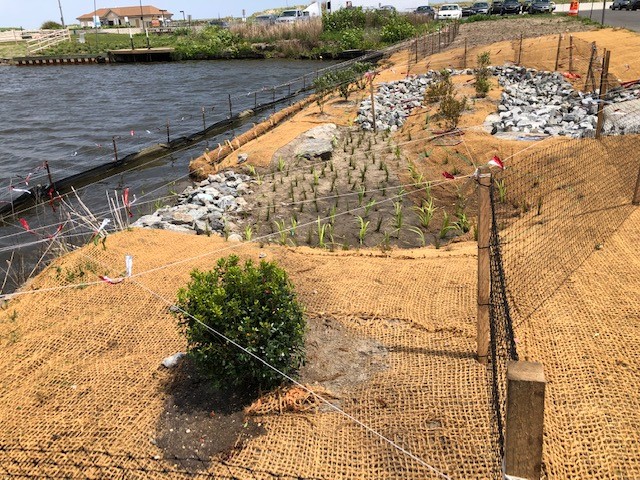Overview
Sylvan lake is one of a series nine “coastal lakes” which historically discharged into the Atlantic Ocean. Along a strip of Monmouth County, NJ, these lakes form the boundaries of the towns. Sylvan Lake divides Avon on the south with Bradley Beach to the north. A valve is shut to the ocean, so the lake has reverted to freshwater. The town of Avon bid this project to convert hard retaining wall to natural living shoreline.
Quick Facts
Geographic Region:
North America
Country or Territory:
United States of America
Biome:
Freshwater
Ecosystem:
Freshwater Ponds & Lakes
Area being restored:
367.2 meters of living shoreline (10 meters wide avg)
Project Lead:
SumCo Eco-Contracting
Organization Type:
Private Company
Project Partners:
SumCo partnered with The Dawson Corporation on this project.
Project Stage:
Completed
Start Date:
2019-03
End Date:
2019-07
Primary Causes of Degradation
Contamination (biological, chemical, physical or radiological), Dams & Hydrology, Urbanization, Transportation & IndustryDegradation Description
The lake is degraded by poor water quality. The entire watershed upstream discharges into the lake, which acts as a “forebay” to capture sediments and contaminants. Since the discharge to the ocean is closed, all the pollutants are confined in the lake. Development in the watershed has added more impervious cover, more runoff, and more pollution.
Some years ago, the town installed two aerating fountains. The fountains improve water quality, but our 368 meters of living shoreline provide superior water quality improvements.
Defining the Reference Ecosystem
The reference ecosystem is primarily based on historical information about ecological attributes at the site prior to degradation.Reference Ecosystem Description
The reference ecosystem is a coastal lake, be it brackish or freshwater. The historical reference was a more healthy system with good fishery. Development over the decades has led to decline in water quality and decline in fishery. By adopting BMPs in the watershed, improved stormwater systems and removal of hard walls, the lake is on a trajectory to improvement.
Project Goals
Ecological goals: improve habitat, improve water quality function.
socio-economic: the project provided public access for kayak/canoe launch, and better recreational asset with improved fishery.
Monitoring
The project does not have a monitoring plan.
Stakeholders
Town of Avon-by-the-Sea
Sylvan Lake Commission
American Littoral Society
How this project eliminated existing threats to the ecosystem:
Remove wooden and stone retaining walls along project shoreline.
Remove all threats of erosion/sediment
Capture runoff in treatment train prior to discharge
Remove dense stand of Japanese knotweed
How this project reinstated appropriate physical conditions (e.g. hydrology, substrate)",:
Biologs were added to extend the shoreline and provide more aquatic bench habitat.
How this project achieved a desirable species composition:
A wealth of species were deployed for each band of wetland/lake edge. All shrubs were wetland indicators such as Buttonbush, Silky dogwood, Winterberry holly, and Bayberry. Aquatics include Pickerelweed, Duck potato, Softstem bulrush, Soft rush, Lizard tail, Spatterdock, and White water lily.
How this project reestablished external exchanges with the surrounding landscape (e.g. migration, gene flow, hydrology):
All point sources were intercepted at point of discharge and routed to a treatment train with some detention, and then discharge.
Activities were undertaken to address any socio-economic aspects of the project:
Public access was provided for recreation activities.
Ecological Outcomes Achieved
Recover ecosystem functionality:
the living shoreline improved water quality. Monitoring data is forthcoming, but anecdotally there is improvement.
Factors limiting recovery of the ecosystem:
Complete build out of the watershed contributing to the lake.
Socio-Economic & Community Outcomes Achieved
Key Lessons Learned
Living shoreline better than hard wall.
Better to install the outer toe (biolog) prior to grading to capture all loose earth and create new wider littoral shelf.
Long-Term Management
monitor for invasive species (Japanese knotweed a concern).
Sources and Amounts of Funding
grant opportunities are available for living shoreline.
Primary Contact
Name:
William Young
Affiliation:
SumCo Eco Contracting
City:
Clarksburg
State:
NJ




